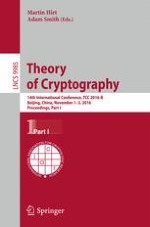2016 | OriginalPaper | Buchkapitel
Secure Multiparty RAM Computation in Constant Rounds
verfasst von : Sanjam Garg, Divya Gupta, Peihan Miao, Omkant Pandey
Erschienen in: Theory of Cryptography
Verlag: Springer Berlin Heidelberg
Aktivieren Sie unsere intelligente Suche, um passende Fachinhalte oder Patente zu finden.
Wählen Sie Textabschnitte aus um mit Künstlicher Intelligenz passenden Patente zu finden. powered by
Markieren Sie Textabschnitte, um KI-gestützt weitere passende Inhalte zu finden. powered by
Abstract
-
Semi-honest model: We present a constant-round black-box secure computation protocol for RAM programs. This protocol is obtained by building on the new black-box garbled RAM construction by Garg, Lu, and Ostrovsky [FOCS 2015], and constant-round secure computation protocol for circuits of Beaver, Micali, and Rogaway [STOC 1990]. This construction allows execution of multiple programs on the same persistent database.
-
Malicious model: Next, we show how to extend our semi-honest results to the malicious setting, while ensuring that the new protocol is still constant-round and black-box in nature.
